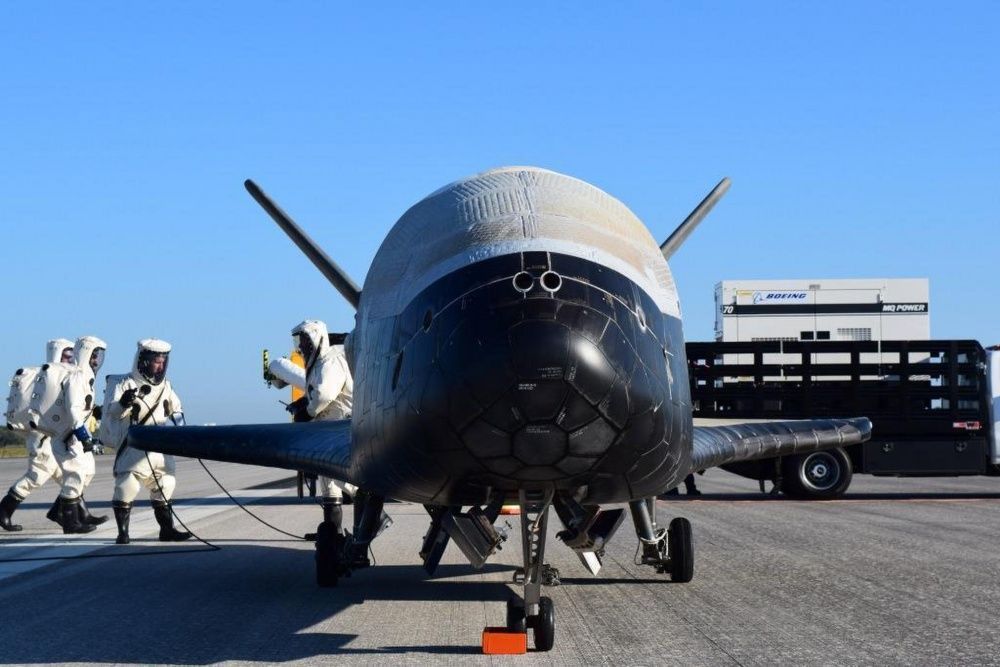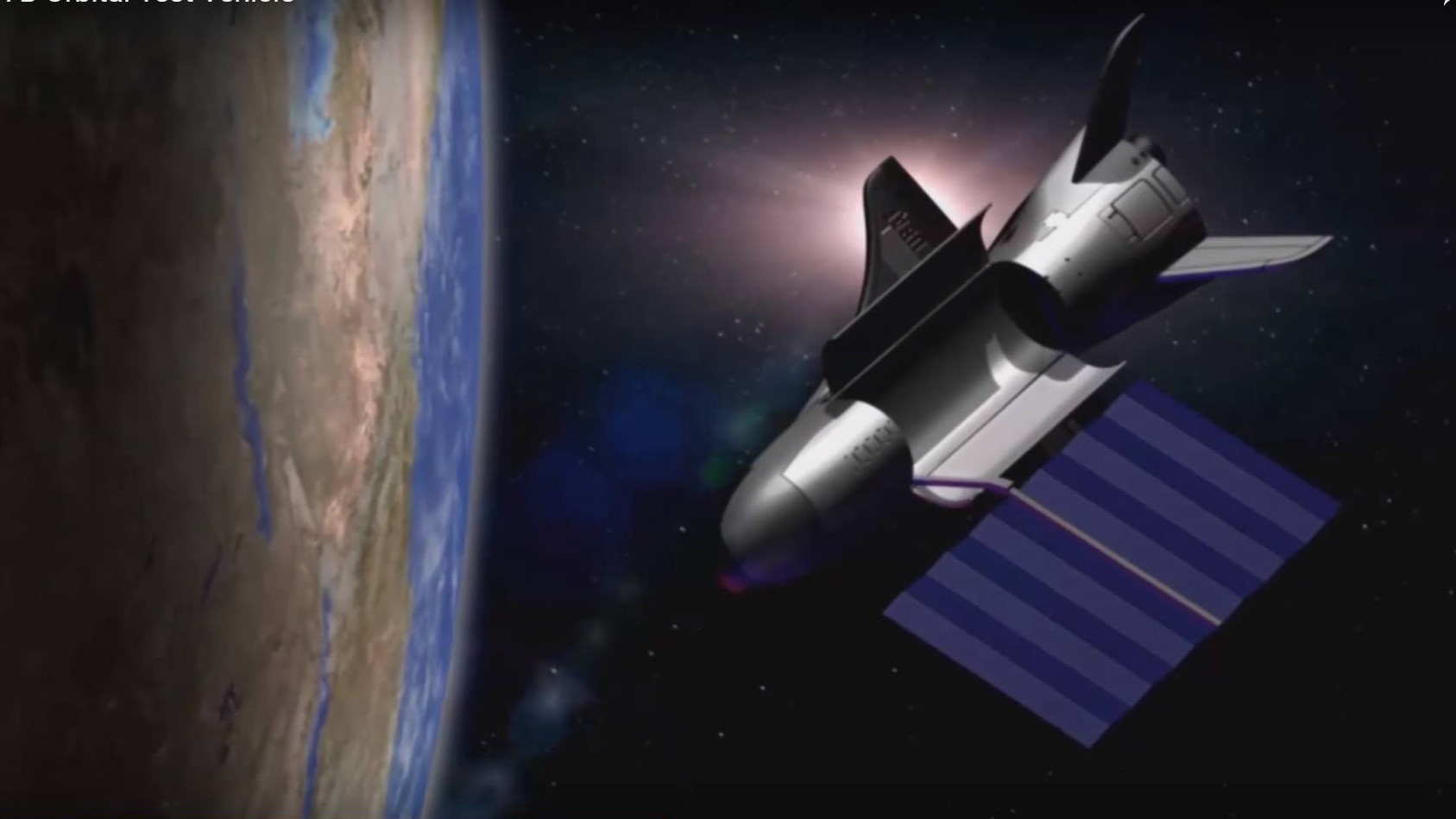US Military Space Plane Wings Past 500 Days on Latest Mystery Mission
The robotic drone is performing classified duties during the program's fifth flight.
The current mission — known as Orbital Test Vehicle (OTV-5) — was rocketed into Earth orbit on Sept. 7, 2017, atop a SpaceX Falcon 9 booster from Launch Complex 39A at NASA's Kennedy Space Center (KSC) in Florida. [The X-37B Space Plane: 6 Surprising Facts]
Space-based demonstrations
X-37B missions are carried out under the auspices of the Air Force Rapid Capabilities Office, and mission control for OTV flights is handled by the 3rd Space Experimentation Squadron at Schriever Air Force Base in Colorado. This squadron oversees operations of the X-37B Orbital Test Vehicle.
This Schriever Air Force Base unit is tagged as the Air Force Space Command’s premier organization for space-based demonstrations, pathfinders and experiment testing, gathering information on objects high above Earth and carrying out other intelligence-gathering duties.
And that may be a signal as to what the robotic craft is doing — both looking down at Earth and upward.
Flight-duration record
Each X-37B/OTV mission has set a new flight-duration record for the program.
OTV-1 began April 22, 2010, and concluded on Dec. 3, 2010, after 224 days in orbit.
Get the world’s most fascinating discoveries delivered straight to your inbox.
OTV-2 began March 5, 2011, and concluded on June 16, 2012, after 468 days on orbit.
OTV-3 chalked up nearly 675 days in orbit before finally coming down on Oct. 17, 2014.
OTV-4 conducted on-orbit experiments for 718 days during its mission, extending the total number of days spent in space for the OTV program at that point to 2,085 days. It was launched in May 2015 and landed in May 2017.
On-orbit testing
Air Force officials haven't divulged much about the current mission. But they have revealed that one payload flying on OTV-5 is the Advanced Structurally Embedded Thermal Spreader, or ASETS-II.
Developed by the U.S. Air Force Research Laboratory (AFRL), this cargo is testing experimental electronics and oscillating heat pipes for long-duration stints in the space environment.
According to the AFRL, the payload’s three primary science objectives are to measure the initial on-orbit thermal performance, to measure long-duration thermal performance and to assess any lifetime degradation.
Tarmac touchdown
Exactly when the space plane will land is unknown.
The previous X-37B mission touched down at KSC's Shuttle Landing Facility on May 7, 2017 — a first for the program. All prior missions had ended with a tarmac touchdown at Vandenberg Air Force Base in California.
Several website postings say that the Air Force aims to launch the sixth X-37B mission, OTV-6, sometime this year aboard a United Launch Alliance Atlas V (501) rocket. The liftoff would be from Cape Canaveral Air Force Station’s Space Launch Complex-41.
Reusable vehicles
The classified X-37B program "fleet" consists of two known reusable vehicles, both of which were built by Boeing.
The Orbital Test Vehicles were fabricated at several Boeing locations in Southern California, including Huntington Beach, Seal Beach and El Segundo. The program transitioned to the U.S. Air Force in 2004 after earlier funded research efforts by Boeing, NASA and the Defense Advanced Research Projects Agency.
Looking like a miniature version of NASA's now-retired space shuttle orbiter, the military space plane is 29 feet (8.8 meters) long and 9.6 feet (2.9 m) tall, with a wingspan of nearly 15 feet (4.6 m).
The X-37B space plane has a payload bay measuring 7 feet (2.1 m) by 4 feet (1.2 m) that can be outfitted with a robotic arm. Each X-37B has a launch weight of 11,000 lbs. (4,990 kilograms) and is powered on orbit by gallium-arsenide solar cells with lithium-ion batteries.
Milestone for the program
Prior to the launch of OTV-5, Randy Walden, the director of the Air Force Rapid Capabilities Office, said there were many firsts on this mission, making it a milestone for the program. "It is our goal to continue advancing the X-37B OTV so it can more fully support the growing space community," Walden said.
The Air Force also noted that the fifth OTV mission was launched into, and will be landed from, a higher-inclination orbit than prior missions to further expand the X-37B’s orbital envelope.
Ground track
Ted Molczan, a Toronto-based satellite analyst, told Inside Outer Space that OTV-5 began September 2018 in an orbit about 243 miles (391 kilometers) high, inclined 54.5 degrees to the equator. Its ground track repeated every three days, after 46 revolutions.
"In mid-September, it lowered its altitude to 214 miles (344 km), which caused its ground track to repeat every two days, after 31 revolutions," Molczan said. "It appeared to still be in approximately that orbit when last observed, on January 26, by Alberto Rango, from Rome, Italy."
Repeating ground tracks are very common, Molczan said, especially for spacecraft that observe the Earth. "I do not know why OTV has repeating ground tracks," he said.
Kevin Fetter, an amateur Canadian satellite spotter in Brockville, Ontario, caught the OTV-5 craft zip by above a bright star. The video can be viewed here.
Editor's note: This story was updated on Jan. 29 to include comments from Ted Molczan.
Leonard David is author of the forthcoming book, "Moon Rush: The New Space Race" to be published by National Geographic in May 2019. A longtime writer for Space.com, David has been reporting on the space industry for more than five decades. Follow us @Spacedotcom or Facebook. This version of the story published on Space.com.

Leonard David is an award-winning space journalist who has been reporting on space activities for more than 50 years.





